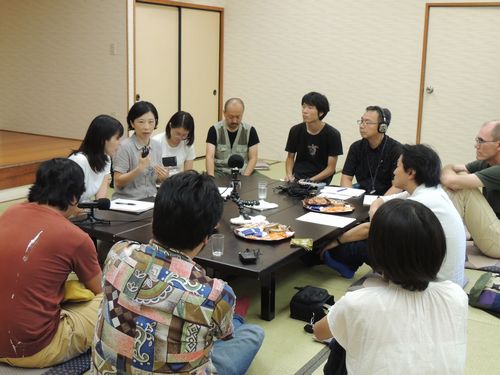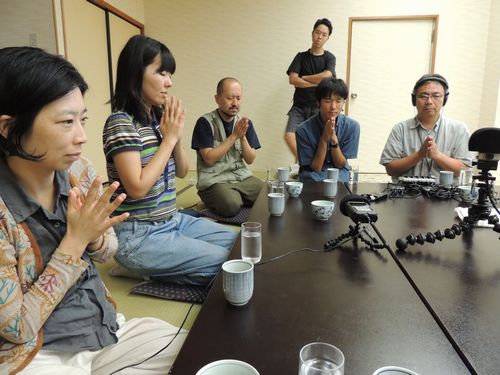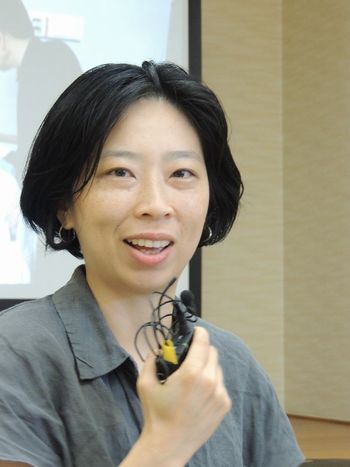No.050 - Interview with Liberal Arts Communicator! KIM Satbyul
Scholar-Artist Collaboration on the Theme of “Mourning”
The National Institutes for the Humanities (NIHU) explores human culture from diverse angles, aiming for coexistence of people and harmony between nature and humanity. We believe that the interchange between society and the locus of research activity is key to deepening the study of the humanities.
In that endeavor, in addition to hosting various research exchange events for the general public, NIHU also trains liberal arts communicators who work to achieve “mutual communication” between scholars and people in society in general. In this series of articles, we introduce these liberal arts communicators and the activities they engage in.
For our third installment, we spoke to KIM Satbyul, who is based at the Research Institute for Humanity and Nature (RIHN), NIHU. Kim has been working on numerous projects since 2017 as our first-ever liberal arts communicator. Here we focus on a film-based research camp that took place September 16–18, 2019 on the theme of “mourning.” (NIHU Interactive Communication Initiative)
In this project, scholars and artists bring together films on a single theme, view them together, and engage in discussion about them. What motivated you to organize an event on this theme?
I received an email one day via RIHN from visual artist JINUSHI Maiko. She was doing research to produce a film about graves and death rituals in the modern era, and, during that process, she happened to have read an article I wrote on the subject. We began corresponding at that time, and our interchange eventually led to me serving as an advisor for her film production for a year or so.
Since we work in different fields, we found our interchange quite stimulating. We often became deeply absorbed in our conversation, and eventually that led to the idea of arranging an event to co-screen Where Are We Going (After We Die)—the film she completed—and my ethnographic film We Don’t Need a Grave from 2014. Despite similarities in what we were trying to convey through our works, there were contrasts between the ways we approached and depicted our subjects. Featuring these two films at the same screening event created a certain synergy.
That experience made me think about the significance of scholar-artist collaboration and, moreover, what it means to put our research into visual form. In recent years RIHN has increasingly been inviting artists to participate in research-based film production endeavors. I came to think that by exploring the synergistic effects of these collaborations, we can examine the core proposition of the NIHU Interactive Communication Initiative —i.e., how visualization efforts can work for the advancement of scholarship (through scholar-artist collaboration). I decided to host a camp accordingly, aiming to articulate the significance of scholar-artist collaboration by having participants engage in in-depth discussion on a single and consistent theme.

Artists and scholars exchanged candid opinions (e.g., what they found disturbing) after viewing each other’s works
Why did you choose “mourning” as the theme?
One reason is because my collaboration with Jinushi, which laid the groundwork for this camp, revolved around my research theme “contemporary death rituals and views on life and death.” Up until my doctoral program, I studied people who practice shizensō—scattering the ashes of the deceased in the ocean or mountains—and explored modern Japanese society’s attitude toward life and death. That led to participating as a co-investigator in a Grants-in-Aid for Scientific Research (KAKEN) project, headed by YAMADA Shinya of the National Museum of Japanese History, titled “A Study of Transformation of Funeral Rituals and Cultural Concepts of Life and Death in Contemporary Japan.” I came to think that working with my collaborators from that project could render the camp meaningful, both for scholars and artists. I decided our theme should be “mourning” instead of “death rituals and views on life and death,” thinking that opening up the topic to the act and general concept of “dealing with death,” rather than limiting it to rituals, would make it easier for artists to participate.
The other reason is because, through my dialogue with Jinushi, I realized that themes relating to death rituals and people’s views on life and death can shed light on some of the debates in the humanities and film production. One example is the ways in which we should approach the subjects of our research and film-making. The invasive nature of research and video-recording becomes apparent at funerals, which are among the most private and pivotal events of a person’s life. I came to think that discussing what it means to engage in research and filming, despite that invasiveness, and talking about how to approach our subjects can contribute greatly to both the humanities and to film production in general.
Each session addressed the event’s core theme “what it means to mourn” from a different perspective. Examples include “The Changing Ways of Mourning and Discoveries from Different Standpoints,” “What It Means to Record a Funeral,” “Identified/Unidentified Remains: Personal and Societal History,” and “The Underground Universe/Illogicality.”
That’s right. The discussions were very candid and provided many insights.
Let me share an interesting episode from our discussion on the theme “The Changing Ways of Mourning and Discoveries from Different Standpoints” that illustrated the stark contrast in the stance artists and scholars take toward knowledge. This is what happened: Jinushi’s film featured a scene where an abandoned grave in an urban cemetery was being demolished. This was happening, I think, because of the absence of anyone to take over responsibility for the grave, recently quite a frequent occurrence. With long, matter-of-fact takes showing the removal process of a structure that previously served as a person’s final abode, Jinushi was apparently asking viewers to contemplate where we go after death.
But her intent did not get across at all to the scholars who specialize in death rituals, because in that scene, workers were removing the exterior stone structures encircling the gravestone. They were not taking down the gravestone itself—which was engraved with the name of the family it represented—or dismantling the stone chamber housing the urns of ashes of the deceased. The scholars were indifferent to this footage because instead of a grave being demolished, what they saw was the removal of grave’s exterior stone structures (which carry little significance). The artist, lacking detailed knowledge of the construction of graves, thought all those features were part of the burial site.
This single episode from the session captures well how scholars’ specialized knowledge can be quite distant from that of the general public.
In the “Identified/Unidentified Remains: Personal and Societal History” session, the participants’ discussion of the general-public perspective of the artist continued. The film screened in this segment featured the funeral procession of a certain minority group. With the artist providing very little commentary or interpretation about this sensitive topic, the film was a matter-of-fact record. After watching the film, a scholar expressed concern about the film. “Recording these scenes without knowing how viewers will interpret them, and simply because the artist is unfamiliar with minority topics could be considered a form of ‘naive invasiveness.’” In response, the artists asserted that the general public is in fact “unfamiliar” with the theme of the film, meaning it has significance as a gateway for ordinary people to approach the issue. The artists went on to argue that choosing not to communicate this topic because it might be invasive to the minority culture could be the problem.
There were even more differences among the participants. In the “What It Means to Record a Funeral” session, participants discussed how to approach their subjects. The artist could not go beyond filming the graveyard, as she believed it would be invasive to film people at a funeral. Professor Yamada, who has long been doing fieldwork about funeral sites, responded that while certainly there is an invasive side to filming memorial services, recording on film could actually initiate an ongoing relationship. Funerals are, by nature, held on short notice. This means research and filming processes start before scholars or artists have time to build a relationship of trust with the subjects. But according to Professor Yamada, long-term interaction with family members and the local community gradually diminish the invasiveness intrinsic to research and filming. He said the scholar is actually the one with the best recollection of the funeral, claiming that family members involved in his research ask questions relating to their memorial service. This shows that far from being “invasive,” scholars could make themselves useful to their subjects.
Persons involved in filmmaking see the final product as a single, complete piece, which is why they may regard the production process as invasive. But the discussion in this session showed that this is not necessarily the case if we look at things from the long-term perspective.

A scene from “The Underground World/Illogicality” session. Participants are exploring the concept of “the inversion of existence.
What results did the discussions and exchange produce?
As I mentioned earlier, the scholars and artists saw many differences between their standpoints. Through discussion, however, they eventually learned that their objective is the same: conveying to as many people as possible what is happening in our modern era. Being able to discover this commonality was a major achievement of the camp, as it means both parties are seeking to record and communicate from their perspectives various events and phenomena of modern society. I believe there is much more that can be done in the realm of scholar-artist collaboration.
I also think having scholars and artists talk about their different stances contributed to highlighting the significance of their cooperation. One example is that, by incorporating the perspective of artists, scholars’ segmented and specialized knowledge can be re-contextualized and made understandable to the public. People often argue that the crux of communication is to convey research results in a readily understandable way. The discussion at our camp revealed that unlike society at large, the specialized knowledge scholars have is segmented, and in order for society to comprehend that knowledge, it needs to be re-contextualized.
The camp also made me think that instead of just criticizing the “naive invasiveness” of artists, we can utilize this concept to find intersections with society by discussing and making adjustments with scholars and research/film subjects.
Lastly, what further research endeavors and activities are you planning to engage in?
The discussions we had at the event were invaluable. I am sure scholar-artist collaboration, which I expect to see increasingly from now on, will benefit from our dialog—which is why I decided not to end the camp as a one-time event and publish a proceedings of our discussions. The book will be available on the RIHN website from April 1, 2020. I hope to see people from a wide range of fields utilize this record.
(Interviewer: Ayumi Hotta)
Overview of film-based research camp on the theme of “Mourning”
====================
Date: Monday, September 16–Wednesday, September 18, 2019
Location: Town of Ibigawa, Ibi, Gifu Prefecture
[Featured films] (Listed in the order of screening)
・KIM Satbyul/RIHN)
KIM Satbyul, We Don’t Need a Grave, directed by KIM Satbyul (2014; London: Royal Anthropological Institute, 2014)
・JINUSHI Maiko/Writer
Where Are We Going (After We Die), 1, “A Cemetery in Tokyo,” directed by JINUSHI Maiko, 2018
・YAMADA Shinya (The National Museum of Japanese History)
YAMADA Shinya, ethnological study film Chiiki shakai no henyō to sōsaigyō-Nagano ken Iida Shimo-ina chihō [Changes in Regional Communities and the Funeral Business -Iidashimoina Area, Nagano Prefecture], directed by YAMADA Shinya, 2004
・Encyclopaedia Cinematographica (EC) films
Shuchō no tsuma no maisō [Burial of the Chief’s Wife]; Onna no jujōsō [Women’s Tree-top Death Rituals]; Kizoku to sono shinzoku futari no onna no sōshiki [Funeral of Nobles and Two Female Relatives]
・CHONG Ri Ae/Writer
Aru tokoro no aru toki ni okeru aru hitori no hanashi to katarikikase- [Story of a Certain Person at a Certain Place and at a Certain Time, and Storytelling-]; Shim chong ga [The Tale of Shim Chong]
・Where Are We Going (After We Die), 5, “Nameless Remains,” directed by JINUSHI Maiko, 2018.
・NITŌ Kento/Writer; screening and presentation
Sonzai-fuzai no hanten ni tsuite (Pompei iseki no kūdo oyobi jisaku wo sansho shinagara) [The Inversion of Existence and Absence (Referencing Empty Spaces from the Ruins of Pompeii and My Work)]
・EC Film
Boketsu hori [Digging a Grave]
[Discussants] (titles omitted)
KIM Satbyul, JINUSHI Maiko, DOI Hiroshi (Institute of Technologists), YAMADA Shinya (National Museum of Japanese History), MALLEE Hein (RIHN), CHONG Ri Ae, URIU Daisuke (University of Tokyo), NITŌ Kento, KAWASE Itsushi (National Museum of Ethnology)

KIM Satbyul,
Liberal Arts Communicator, National Institutes for the Humanities / Specially Appointed Assistant Professors,
Research Institute for Humanity and Nature
Born in South Korea, Kim received her PhD at the School of Cultural and Social Studies, Graduate University for Advanced Studies, in 2016. She specializes in cultural anthropology, focusing on death and burial rituals and visual anthropology. She took up her present position as Project Assistant Professor in 2017.
